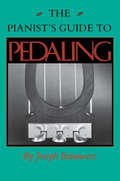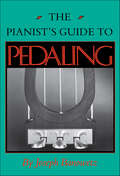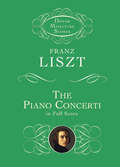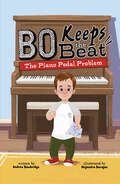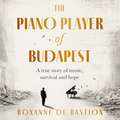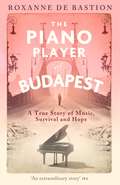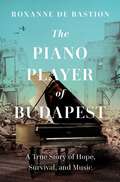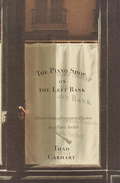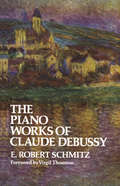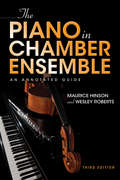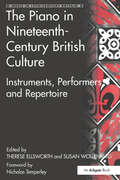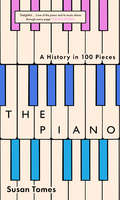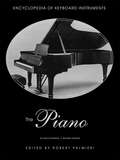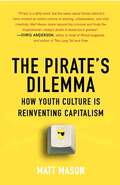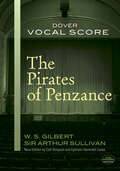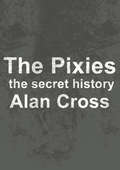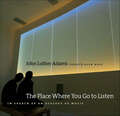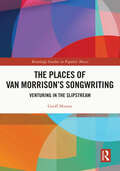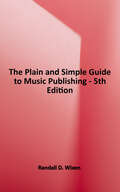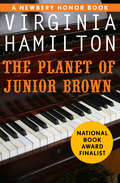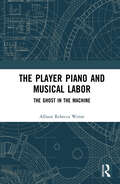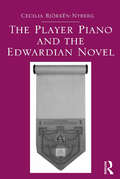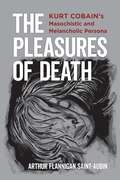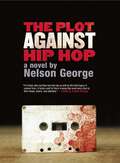- Table View
- List View
The Pianist's Guide to Pedaling
by Joseph BanowetzJoseph Banowetz and four distinguished contributors provide practical suggestions and musicological insights on the pedaling of keyboard works from the 18th to the 20th century.
The Pianist's Guide to Pedaling
by Joseph Banowetz" . . . a most precious book which every serious pianist and teacher must own." —Journal of the American Liszt SocietyJoseph Banowetz and four distinguished contributors provide practical suggestions and musicological insights on the pedaling of keyboard works from the 18th to the 20th century.
The Piano Concerti
by Franz LisztOne of the greatest piano virtuosos of all time, Franz Liszt composed piano music marked by its technical brilliance, innovation, and imagination. This collection presents authoritative miniature score editions of two staples of the repertoire: Liszt's Piano Concerto No. 1 in E-flat Major and his Piano Concerto No. 2 in A Major.The works are reproduced here from authoritative editions, complete with bar-numbered movements for easy reference. Affordable, durable, and portable, this miniature score edition is ideal for study in the classroom, at home, or in the concert hall.
The Piano Pedal Problem (Bo Keeps the Beat)
by Andrew BambridgeBo really wants to take piano lessons like his older brother Jason. But there are two problems—his mom says he’s not ready, and his feet can’t reach the foot pedals because of his achondroplasia. But Bo knows that where there’s a problem, there’s a solution! With determination and the help of a kind teacher, Bo tackles the piano problem, and his feet and fingers finally feel the music! Musician, educator, and actor Andrew Bambridge (Pixels) offers a charming chapter book series about a boy named Bo who, like Andrew, has achondroplasia and has always loved music.
The Piano Player of Budapest: A True Story of Holocaust Survival, Music and Hope
by Roxanne de BastionOne man, his piano and their miraculous survival.'Extraordinary' Baroness Julia Neuberger'Stunning. A beautiful blend of action, poetry, thought-provoking comment and music ... just brilliant' James Ainscough OBE'A gripping narrative of suffering, loss and survival, with music at its heart' Fiona MaddocksAll future, freedom and success lay ahead of young pianist Stephen de Bastion in 1930s Hungary. Life whirled headily around cocktails, romance, applause and the buzz of Budapest late into the night. Then, 1939. Stephen's world disintegrates and this becomes a story of his brutal descent, of his time in labour camps, of Mauthausen and Gunskirchen and the unimaginable horrors he endured during the Holocaust as a man of Jewish descent. Yet, this is also a tale of extraordinary escape ... and the piano, waiting for him.The same piano that Roxanne de Bastion, his granddaughter, inherits when her father dies. It has been in the family over one hundred years but it is only when, deep in grief, she discovers a cassette recording of Stephen, that the astonishing history of the piano, the man and her family begins to unravel. Weaving together his original recordings, unpublished memoirs, letters and documents, Roxanne sings out her grandfather's story of music and hope, lost and found. Luminous and profoundly moving, this book captures the great spirit of one man in the face of darkness and the hope that echoes down through generations.
The Piano Player of Budapest: A True Story of Holocaust Survival, Music and Hope
by Roxanne de BastionOne man, his piano and their miraculous survival.'Extraordinary' Baroness Julia Neuberger'Stunning. A beautiful blend of action, poetry, thought-provoking comment and music ... just brilliant' James Ainscough OBE'A gripping narrative of suffering, loss and survival, with music at its heart' Fiona MaddocksAll future, freedom and success lay ahead of young pianist Stephen de Bastion in 1930s Hungary. Life whirled headily around cocktails, romance, applause and the buzz of Budapest late into the night. Then, 1939. Stephen's world disintegrates and this becomes a story of his brutal descent, of his time in labour camps, of Mauthausen and Gunskirchen and the unimaginable horrors he endured during the Holocaust as a man of Jewish descent. Yet, this is also a tale of extraordinary escape ... and the piano, waiting for him.The same piano that Roxanne de Bastion, his granddaughter, inherits when her father dies. It has been in the family over one hundred years but it is only when, deep in grief, she discovers a cassette recording of Stephen, that the astonishing history of the piano, the man and her family begins to unravel. Weaving together his original recordings, unpublished memoirs, letters and documents, Roxanne sings out her grandfather's story of music and hope, lost and found. Luminous and profoundly moving, this book captures the great spirit of one man in the face of darkness and the hope that echoes down through generations.
The Piano Player of Budapest: A True Story of Survival, Hope, and Music
by Roxanne de BastionA story about a piano and its most prodigious player—and how they both survived one of the darkest periods in history.When her father died, singer-songwriter Roxanne de Bastion inherited a piano she knew had been in her family for over a hundred years. But it is only when she finds a cassette recording of her grandfather, Stephen, playing one of his compositions, that the true and almost unbelievable history of the piano, this man, and her family begins to unravel. Stephen was a man who enjoyed great fame, a man who suffered the horrors of concentration camps in WWII, a man who ultimately survives—along with his piano. By piecing together his cassette recordings, unpublished memoirs, letters, and documents, Roxanne sings out her grandfather's story of music and hope, lost and found, and explores the power of what can echo down through generations.
The Piano Shop on the Left Bank
by Thad CarhartThad Carhart never realized there was a gap in his life until he happened upon Desforges Pianos, a demure little shopfront in his Pairs neighborhood that seemed to want to hide rather than advertise its wares. Like Alice in Wonderland, he found his attempts to gain entry rebuffed at every turn. An accidental introduction finally opened the door to the quartier's oddest hangout, where locals -- from university professors to pipefitters -- gather on Friday evenings to discuss music, love, and life over a glass of wine.Luc, the atelier's master, proves an excellent guide to the history of this most gloriously impractical of instruments. A bewildering variety passes through his restorer's hands: delicate ancient pianofortes, one perhaps the onetime possession of Beethoven. Great hulking beasts of thunderous voice. And the modest piano "with the heart of a lion" that was to become Thad's own.What emerges is a warm and intuitive portrait of the secret Paris -- one closed to all but a knowing few. The Piano Shop on the Left Bank is the perfect book for music lovers, or for anyone who longs to recapture a lost passion.From the Hardcover edition.
The Piano Works of Claude Debussy (Dover Books on Music)
by E. Robert SchmitzThis book is a firsthand report of a great composer's intentions in regard to the performance of his music. These intentions have been digested and interpreted for us by the composer's friend Robert Schmitz (1889–1949), who was himself a distinguished pianist, an articulate musician, and a well-known teacher. The product is an authoritative commentary on the entire body of Debussy's work for piano solo.Written for both performers and listeners, the book's purpose is to increase enjoyment of and insight into these works. The book's shorter opening section comprises notes on many general aspects of the composer's life and work; a biographical sketch; a discussion of Debussy's place in relation to the concepts of impressionism and romanticism; his use of classical forms, tonality and modality, melody, counterpoint, etc. Section two, the heart of the book, examines in detail the whole of Debussy's music for solo piano, two hands. Seventy-one pieces in all are included: The Arabesques, the Suite Bergmasque, the Estampes, Images, Children's Corner, Préludes and Études. Each in its chronological place, the pieces are first described as a whole as to mood, source of programmatic inspiration, structure, tonality, and other characteristics. Then follows specific suggestions dealing with technical and expressive problems of particular measures and phrases.The book is not meant as a substitute for Debussy's piano works; on the contrary, it will cause both listeners and performers to turn to this superb corpus of music with new interest and insight. "Complete, thorough, authoritative and important." — San Francisco Chronicle. "It is a thoughtful and mature reference book and though I am at variance with certain of its premises and conclusions, there is much to provoke the intelligent music lover and the inquiring musician." — Abram Chasins, The New York Times. "There is no doubt that he had closely identified himself with the great French composer, and his love and belief in the music shine through every page of this book." — H. C. Schonbert, The Saturday Review.
The Piano in Chamber Ensemble, Third Edition: An Annotated Guide
by Maurice Hinson Wesley RobertsIn this expanded and updated edition, The Piano in Chamber Ensemble: An Annotated Guide features over 3200 compositions, from duos to octets, by more than 1600 composers. Maurice Hinson and Wesley Roberts catalog published works for piano with two or more instruments with information on performance level, length, individual movements, overall style, and publisher. Divided into sections according to the number and types of instruments involved, The Piano in Chamber Ensemble then subdivides entries according to the actual scoring. Keyboard, string, woodwind, brass, and percussion players and teachers will find a wealth of chamber works from all periods in this invaluable guide.
The Piano in Nineteenth-Century British Culture: Instruments, Performers and Repertoire (Music In Nineteenth-century Britain Ser.)
by THERESE ELLSWORTH and SUSAN WOLLENBERGSince the publication of The London Pianoforte School (ed. Nicholas Temperley) twenty years ago, research has proliferated in the area of music for the piano during the late eighteenth and nineteenth centuries and into developments in the musical life of London, for a time the centre of piano manufacturing, publishing and performance. But none has focused on the piano exclusively within Britain. The eleven chapters in this volume explore major issues surrounding the instrument, its performers and music within an expanded geographical context created by the spread of the instrument and the growth of concert touring. Topics covered include: the piano trade and how piano manufacturing affected a major provincial town; the reception of Bach's Well-Tempered Clavier and Clementi's Gradus ad Parnassum during the nineteenth century; the shift from composer-pianists to pianist-interpreters in the first half of the century that triggered crucial changes in piano performance and concert structure; the growth of musical life in the peripheries outside major musical centres; the pianist as advocate for contemporary composers as well as for historical repertory; the status of British pianists both in relation to foreigners on tour in Britain and as welcomed star performers in outposts of the Empire; marketing forces that had an impact on piano sales, concerts and piano careers; leading virtuosos, writers and critics; the important role played by women pianists and the development of the recording industry, bringing the volume into the early twentieth century.
The Piano: A History in 100 Pieces
by Susan TomesA fascinating history of the piano explored through 100 pieces chosen by one of the UK&’s most renowned concert pianists An astonishingly versatile instrument, the piano allows just two hands to play music of great complexity and subtlety. For more than two hundred years, it has brought solo and collaborative music into homes and concert halls and has inspired composers in every musical genre—from classical to jazz and light music. Charting the development of the piano from the late eighteenth century to the present day, pianist and writer Susan Tomes takes the reader with her on a personal journey through 100 pieces including solo works, chamber music, concertos, and jazz. Her choices include composers such as Bach, Mozart, Beethoven, Robert Schumann, Tchaikovsky, Debussy, Gershwin, and Philip Glass. Looking at this history from a modern performer&’s perspective, she acknowledges neglected women composers and players including Fanny Mendelssohn, Maria Szymanowska, Clara Schumann, and Amy Beach.
The Piano: An Encyclopedia
by Robert Palmieri Margaret W. PalmieriFirst Published in 2011. Routledge is an imprint of Taylor & Francis, an informa company.
The Pirate's Dilemma: How Youth Culture Is Reinventing Capitalism
by Matt MasonIt started with punk. Hip-hop, rave, graffiti, and gaming took it to another level, and now modern technology has made the ideas and innovations of youth culture increasingly intimate and increasingly global at the same time. In The Pirate's Dilemma, VICE magazine's Matt Mason -- poised to become the Malcolm Gladwell of the iPod Generation -- brings the exuberance of a passionate music fan and the technological savvy of an IT wizard to the task of sorting through the changes brought about by the interface of pop culture and innovation. He charts the rise of various youth movements -- from pirate radio to remix culture -- and tracks their ripple effect throughout larger society. Mason brings a passion and a breadth of intelligence to questions such as the following: How did a male model who messed with disco records in the 1970s influence the way Boeing designs airplanes? Who was the nun who invented dance music, and how is her influence undermining capitalism as we know it? Did three high school kids who remixed Nazis into Smurfs in the 1980s change the future of the video game industry? Can hip-hop really bring about world peace? Each chapter crystallizes the idea behind one of these fringe movements and shows how it combined with technology to subvert old hierarchies and empower the individual. With great wit and insight -- and a cast of characters that includes such icons as the Ramones, Andy Warhol, Madonna, Russell Simmons, and 50 Cent -- Mason uncovers the trends that have transformed countercultural scenes into burgeoning global industries and movements, ultimately changing our way of life.
The Pirates of Penzance Vocal Score
by W. S. Gilbert Carl Simpson Ephraim Hammett Jones Sir Arthur SullivanThis exemplary new edition of the vocal score of an enchanting operetta -- which has delighted audiences for over a century with its catchy melodies, its witty lyrics, and its madcap tale of tender-hearted pirates, timid policemen, and the demands of duty -- was prepared by musicologists Carl Simpson and Ephraim Hammett Jones, who returned to original manuscripts and early sources to produce handsome, newly engraved plates closest to Gilbert and Sullivan's original intentions. All of the voice parts appear here, in addition to a piano reduction of the full score and the complete libretto. Introduction by the editors. Contents. Instrumentation.
The Pixies: The Secret History (The\secret History Of Rock Ser.)
by Alan CrossAlan Cross is the preeminent chronicler of popular music.Here he provides a history of trailblazing grunge band The Pixies.This look at the band—"Music from the Planet of Sound"—is adapted from the audiobook of the same name.
The Place Where You Go to Listen: In Search of an Ecology of Music
by John Luther AdamsDid Alaska create the music of John Luther Adams, or did the music create his Alaska? For the past thirty years, the vastness of Alaska has swept through the distant reaches of the composer's imagination and every corner of his compositions. In this new book Adams proposes an ideal of musical ecology, the philosophical foundation on which his largest, most complex musical work is based. This installation, also called The Place Where You Go to Listen, is a sound and light environment that gives voice to the cycles of sunlight and darkness, the phases of the moon, the seismic rhythms of the earth, and the dance of the aurora borealis. Adams describes this work as "a place for hearing the unheard music of the world around us." The book includes two seminal essays, the composer's journal telling the story of the day-to-day emergence of The Place, as well as musical notations, graphs and illustrations of geophysical phenomena.
The Places of Van Morrison’s Songwriting: Venturing in the Slipstream (Routledge Studies in Popular Music)
by Geoff MunnsWhat can we learn about Van Morrison’s life and work as a songwriter through his songs? This book looks closely at the lyrics and music from a selection of his songs. Some are very well-known - ‘Brown Eyed Girl’, ‘Cleaning Windows’ and ‘The Healing Game’. Others are less familiar. Through these songs the book offers insights into some of the most important ideas that the songwriter has explored across his five-decade plus career, starting from the Them period and extending through his solo albums. These readings show how thinking about Morrison’s use of place provides a specific lens that contributes to a greater understanding of his art. The songs are organized into chapters that reflect many of the important places in Morrison’s work as he ventured professionally and imaginatively away from the places of his upbringing towards a wider musical world. These places are in city streetscapes and country landscapes – in home places of streets and ditches, in the enclosed spaces of rooms, in the expansive reaches of the natural world, in indeterminate and specific foreign lands. A picture emerges of the journey that Van Morrison details through his songs, one that sees him first wandering as a boy through his East Belfast haunts, and then venturing out to a wider world away from this local place.
The Plain & Simple Guide to Music Publishing, 5th Edition
by Randall D. WixenMusic publishing is one of the most complex parts of the music business, and yet it can be the most lucrative area of income for musicians. Expert and industry veteran Randall Wixen presents a clear, concise approach on how music publishing works today. It is written for the lay musician/songwriter but contains enough substance to be worthwhile for those already holding positions within the business. Includes a foreword by Tom Petty. Topics covered include everything from mechanical, performing, and sync rights to sub-publishing, foreign rights, copyright basics, types of publishing deals, advice on representation, and more.
The Planet of Junior Brown: Zeely / The House Of Dies Drear / The Planet Of Junior Brown / M. C. Higgins, The Great / Sweet Whispers, Brother Rush
by Virginia HamiltonJunior Brown is a musical prodigy losing touch with reality and everyone around him—except for one important friend Junior Brown is different than the other kids in his eighth-grade class. For one, he weighs three hundred pounds. He&’s also a talented musician with a serious future as a professional pianist—if he survives middle school. With an overbearing mom, disappointed teachers, and fellow students who tease him mercilessly, Junior starts to slip away into his own mind. His last hope may be his only friend, Buddy Clark, a boy in his class without a home or family who has already learned some of life&’s toughest lessons.
The Player Piano and Musical Labor: The Ghost in the Machine
by Allison Rebecca WenteBy the early 20th century the machine aesthetic was a well-established and dominant interest that fundamentally transformed musical performance and listening practices. While numerous scholars have examined this aesthetic in art and literature, musical compositions representing industrialized labor practices and the role of the machine in music remain largely unexplored. Moreover, in recounting the history of machines in musical recording and reproduction, scholars often tend to emphasize the phonograph, rather than player piano, despite the latter’s prominence within the newly established musical marketplace. Machines and their music influenced multiple areas of early 20th-century musical culture, from film scores to popular music and even the concert hall. But the opposite was also true: industrialized labor practices changed the musical marketplace and musical culture as a whole. As consumers accepted mechanical replacements for what previously required an active human laborer, ghostly, mechanical performers labored tirelessly in parlors, businesses, and even concert halls. Although the player piano failed to maintain a stronghold in the recorded music marketplace after 1930, the widespread acceptance of recording technologies as media for storing and enjoying music indicates a much more fundamental societal shift. This book explores that shift, examining the rise and fall of the player piano in early 20th-century society and connecting it to the digital technologies of today.
The Player Piano and the Edwardian Novel
by Cecilia Bjorken-NybergIn her study of music-making in the Edwardian novel, Cecilia Bjorkén-Nyberg argues that the invention and development of the player piano had a significant effect on the perception, performance and appreciation of music during the period. In contrast to existing devices for producing music mechanically such as the phonograph and gramophone, the player piano granted its operator freedom of individual expression by permitting the performer to modify the tempo. Because the traditional piano was the undisputed altar of domestic and highly gendered music-making, Bjorkén-Nyberg suggests, the potential for intervention by the mechanical piano's operator had a subversive effect on traditional notions about the status of the musical work itself and about the people who were variously defined by their relationship to it. <P><P> She examines works by Dorothy Richardson, E.M. Forster, Henry Handel Richardson, Max Beerbohm and Compton Mackenzie, among others, contending that Edwardian fiction with music as a subject undermined the prevalent antithesis, expressed in contemporary music literature, between a nineteenth-century conception of music as a means of transcendence and the increasing mechanisation of music as represented by the player piano. Her timely survey of the player piano in the context of Edwardian commercial and technical discourse draws on a rich array of archival materials to shed new light on the historically conditioned activity of music-making in early twentieth-century fiction.
The Pleasures of Death: Kurt Cobain’s Masochistic and Melancholic Persona
by Arthur Flannigan Saint-AubinThe year 2019 marked the twenty-fifth anniversary of the death of Kurt Cobain, an artist whose music, words, and images continue to move millions of fans worldwide. As the first academic study that provides a literary analysis of Cobain’s creative writings, Arthur Flannigan Saint-Aubin’s The Pleasures of Death: Kurt Cobain’s Masochistic and Melancholic Persona approaches the journals and songs crafted by Nirvana’s iconic front man from the perspective of cultural theory and psychoanalytic aesthetics.Drawing on critiques and reformulations of psychoanalytic theory by feminist, queer, and antiracist scholars, Saint-Aubin considers the literary means by which Cobain creates the persona of a young, white, heterosexual man who expresses masochistic and melancholic behaviors. On the one hand, this individual welcomes pain and humiliation as atonement for unpardonable sins; on the other, he experiences a profound sense of loss and grief, seeking death as the ultimate act of pleasure. The first-person narrators and characters that populate Cobain’s texts underscore the political and aesthetic repercussions of his art. Cobain’s distinctive version of grunge, understood as a subculture, a literary genre, and a cultural practice, represents a specific performance of race and gender, one that facilitates an understanding of the self as part of a larger social order. Saint-Aubin approaches Cobain’s writings independently of the artist’s biography, positioning these texts within the tradition of postmodern representations of masculinity in twentieth-century American fiction, while also suggesting connections to European Romantic traditions from the nineteenth century that postulate a relation between melancholy (or depression) and creativity. In turn, through Saint-Aubin’s elegant analysis, Cobain’s creative writings illuminate contradictions and inconsistencies within psychoanalytic theory itself concerning the intersection of masculinity, masochism, melancholy, and the death drive.By foregrounding Cobain’s ability to challenge coextensive links between gender, sexuality, and race, The Pleasures of Death reveals how the cultural politics and aesthetics of this tragic icon’s works align with feminist strategies, invite queer readings, and perform antiracist critiques of American culture.
The Plot Against Hip Hop: A Novel (A D Hunter Mystery #2)
by Nelson GeorgeFinalist for the 2012 NAACP Image Award in Literature!"George is an ace at interlacing the real dramas of the world...the book's slim length and flyweight depth could make it an artifact of this particular zeitgeist in American history. Playas and haters and celebrity cameos fuel a novel that is wickedly entertaining while being frozen in time."--Kirkus Reviews"This hard-boiled tale is jazzed up with authentic street slang and name-dropping (Biggie, Mary J. Blige, Lil Wayne, and Chuck D)...George's tightly packaged mystery pivots on a believable conspiracy...and his street cred shines in his descriptions of Harlem and Brownsville's mean streets."--Library Journal"George is a well-known, respected hip-hop chronicler...Now he adds crime fiction to his resume with a carefully plotted crime novel peopled by believable characters and real-life hip-hop personalities."--Booklist"George's prose sparkles with an effortless humanity, bringing his characters to life in a way that seems true and beautiful. The story--and the conspiracy behind it--is one we all need to hear as consumers and creators in the post-hardcore hip-hop world."--Shelf Awareness"Part procedural murder mystery, part conspiracy-theory manifesto, Nelson George's The Plot Against Hip Hop reads like the PTSD fever dream of a renegade who's done several tours of duty in the trenches...Plot's combination of record-biz knowledge and ghetto fabulosity could have been written only by venerable music journalist Nelson George, who knows his hip-hop history...The writing is as New York as 'Empire State of Mind,' and D is a detective compelling enough to anchor a series."--Time Out New York"A breakbeat detective story...George invents as much as he curates, as outlandish conspiracy theories clash with real-life figures. But what makes the book such a fascinating read is its simultaneous strict adherence to hip-hop's archetypes and tropes while candidly acknowledging the absurdity of the music's current big-business era. There's a late-capitalism logic at work here. If this book had been written in the early '90s, it would have been about the insurgent artistry of hip-hop musicians and the social-justice strides the genre was effecting. Today, it's a procedural about the death of principles."--Time Out Chicago"Like good hip hop, there is social commentary and a blurring of the lines between great storytelling and all-to-real happenings. The Plot Against Hip Hop reads almost like Thomas Pynchon's Inherent Vice, but in the world of rap music. Brilliant prose, vast conspiracy, (at times) borderline trippy narrative. If you love crime fiction and you love hip hop, this book is a must read."--BookRiot"The Plot Against Hip Hop is a quick-moving murder mystery that educates its audience on Hip Hop's pioneer generation along the way...it is a nostalgic look at a magical and manic moment in time."--New York Journal of Books"George very masterfully has created a novel that informs as well as entertains."--Huffington PostThe Plot Against Hip Hop is a noir novel set in the world of hip hop culture. The stabbing murder of esteemed music critic Dwayne Robinson in a Soho office building is dismissed by the NYPD as a gang initiation. But his old friend, bodyguard and security expert D Hunter, suspects there are larger forces at work.D Hunter's investigation into his mentor's murder leads into a parallel history of hip hop, a place where renegade government agents, behind-the-scenes power brokers, and paranoid journalists know a truth that only a few hardcore fans suspect. This rewrite of hip hop history mixes real-life figures with characters pulled from the culture's hidden world, including Jay-Z, Kanye West, and Russell Simmons.
The Pocket DJ
by Sarah LewitinnWith more than two thousand songs handpicked and organized by former Spin magazine writer and editor Sarah Lewitinn (aka Ultragrrrl), The Pocket DJ is the ultimate insider's reference guide for selecting music, downloading MP3s, and making all-purpose mixes for every occasion imaginable
